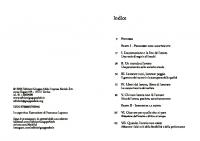A Practical Guide to Ore Microscopy―Volume 2: Ore Textures and Automated Ore Analysis [1st ed. 2023] 3031189531, 9783031189531
This book presents recent developments in ore microscopy to support the work of engineers and scientists actively engage
124 76 37MB
English Pages 319 [309] Year 2023
Foreword
Contents
Intergrowths. Textural Analysis
1 Intergrowths and Textures
1.1 Textural Analysis
1.2 Classification Criteria for Textural Analysis
1.2.1 Descriptive Classification
1.2.2 Genetic Classification
1.2.3 Geometallurgical Classification
1.3 Interpretive Keys: How to Define and Interpret Textures
1.3.1 Cavity or Vein Infill
1.3.2 Alteration and Replacement
1.3.3 Colloidal Textures
1.3.4 Geometallurgical Applications
1.4 Concluding Statement: Automated Ore Analysis
References
Automated Ore Analysis
2 Automated Analysis of Ores and Plant Concentrates
2.1 The AMCO System
2.2 Methodology
2.3 Image Acquisition
2.4 Image Analysis
2.5 Databases: Construction and Validation
2.6 Results: Automated Identification and Geometallurgical Application
2.7 Supplement
References
Appendix_1
Analytical Index of Minerals Described*
Selected Ore Minerals—Learning Priority 1
Selected Ore Minerals—Learning Priority 2
Most Common Gangue Minerals
Most Common Gangue Minerals
Annex 1.1.a All Described Minerals’ Symbols or Abbreviations and Comments
Annex 1.1.m All Described Minerals and their Symbols or Abbreviations and Comments
Annex 1.2.a Ore Mineral Symbols or Abbreviations and Comments
Annex 1.2.m Ore Minerals and their Symbols or Abbreviations and Comments
Annex 1.3.a Gangue Mineral Abbreviations and Comments
Annex 1.3.m Gangue Minerals and their Abbreviations and Comments
Annex 1.4 Glossary MAAS Meanings of Acronyms, Abbreviations and Symbols
Outline placeholder
A.1.4.1 Acronyms and Abbreviations
A.1.4.2 Symbols
A.1.4.2 Symbols
Par405
Annex 2.1 Main Classes of Metal Deposits: Simplified Typology
Annex 2.2 Mineral Associations by Deposit Class (cf. Annex 2.1)
Annex 2.2 Mineral Associations by Deposit Class (cf. Annex 2.1)
Sec10
Appendix_5
Annex 4.1 Specular Reflectance of Common Ores(*) (Estimated Values in Air, White Light)
Annex 4.2 Polishing Hardness and Scratch Hardness
Annex 4.2.2 Talmage Hardness (Talm H)(*)
Annex 4.3 Minerals with Distinct Internal Reflections (I.R.)
Annex 4.4 Distinctly Bireflective or Pleochroic Ores
Annex 4.5 Isotropic or Very Weakly Anisotropic Minerals(*)
Annex 4.6 Polarization Colors of Distinctly Anisotropic Ores(*)
Annex 4.7 Common Ores with Typical Natural Colors
Annex 4.7 Common Ores with Typical Natural Colors
Outline placeholder
Sec14
Annex 5.2 Determinative Strategy and Use of the Tables
Recommend Papers
![A Practical Guide to Ore Microscopy―Volume 2: Ore Textures and Automated Ore Analysis [1st ed. 2023]
3031189531, 9783031189531](https://ebin.pub/img/200x200/a-practical-guide-to-ore-microscopyvolume-2-ore-textures-and-automated-ore-analysis-1st-ed-2023-3031189531-9783031189531.jpg)
- Author / Uploaded
- Ricardo Castroviejo
File loading please wait...
Citation preview
Ricardo Castroviejo
A Practical Guide to Ore Microscopy —Volume 2 Ore Textures and Automated Ore Analysis
A Practical Guide to Ore Microscopy—Volume 2
Ricardo Castroviejo
A Practical Guide to Ore Microscopy—Volume 2 Ore Textures and Automated Ore Analysis
123
Ricardo Castroviejo E.T.S. de Ingenieros de Minas y Energía Universidad Politécnica de Madrid Madrid, Spain
ISBN 978-3-031-18953-1 ISBN 978-3-031-18954-8 https://doi.org/10.1007/978-3-031-18954-8
(eBook)
© The Editor(s) (if applicable) and The Author(s), under exclusive license to Springer Nature Switzerland AG 2023 This work is subject to copyright. All rights are solely and exclusively licensed by the Publisher, whether the whole or part of the material is concerned, specifically the rights of reprinting, reuse of illustrations, recitation, broadcasting, reproduction on microfilms or in any other physical way, and transmission or information storage and retrieval, electronic adaptation, computer software, or by similar or dissimilar methodology now known or hereafter developed. The use of general descriptive names, registered names, trademarks, service marks, etc. in this publication does not imply, even in the absence of a specific statement, that such names are exempt from the relevant protective laws and regulations and therefore free for general use. The publisher, the authors, and the editors are safe to assume that the advice and information in this book are believed to be true and accurate at the date of publication. Neither the publisher nor the authors or the editors give a warranty, expressed or implied, with respect to the material contained herein or for any errors or omissions that may have been made. The publisher remains neutral with regard to jurisdictional claims in published maps and institutional affiliations. This Springer imprint is published by the registered company Springer Nature Switzerland AG The registered company address is: Gewerbestrasse 11, 6330 Cham, Switzerland
Dedico este libro, fruto de un esfuerzo compartido, a Antonia, mi amiga, esposa y apoyo abnegado en momentos difíciles. (This book, the fruit of a shared effort, is dedicated to Antonia, my friend, wife and selfless support in difficult times.)
Foreword
Congratulations on acquiring the most useful book on ore microscopy! You’ll find the book packed with information relevant to geologists, metallurgists, and others interested in not only ore minerals but all common minerals that are opaque in transmitted light. Following the adage “when all else fails, look at the rock,” this book is a first-rate text on how to maximize the use of a polarizing reflected-light microscope (covered in Part I), identify more than 150 ore minerals (Part II) and more than 50 gangue minerals with which they are commonly associated (Part III), interpret intergrowths of minerals for geological interpretations of ore-forming processes and for applications in geometallurgy and environmental considerations (Part IV), and use the light microscope for image-analysis automation in a much less expensive but complementary approach to scanning electron microscope (SEM)based techniques (Part V). The photographs of ore and gangue minerals in all chapters are as accurate in color as possible and provide excellent examples culled from worldwide collections. Each ore mineral in Part II is photographed under the four types of illumination commonly used in reflected-light petrography (plane polarized light in air then with oil plus crossed polarized light in both air and oil). The photographs in Part IV are illustrative of the intergrowths that are essential to accurate characterization of mineral resources and reserves, including potential difficulties in ore processing and waste disposal. The book comes in two volumes, with Parts I–III in Volume 1 and Parts IV and V plus references and annexes (appendices) in Volume 2. The annexes are exceptionally useful. They address common associations of ore and gangue minerals (#2), techniques for the preparation of polished sections (#3), tables of mineral properties (#4), and well-proven determinative tables (#5). Professor Castroviejo has spent his career using ore microscopy in research and applications to industry. He demonstrates that reflected light microscopy remains the most cost-effective approach to characterize and interpret ores in terms of genesis, mineral processing, and environmental concerns during and after production. Although SEM, electron microprobe, and other chemical analytical techniques are essential, the ore microscope remains the first and best approach to look at the rocks. Jonathan G. Price Ph.D. State Geologist Emeritus Nevada Bureau of Mines and Geology University of Nevada, Reno Nevada, NV, USA
vii
Acknowledgements
This work has benefited from the generous support of numerous individuals and institutions. Being impossible to name them all, I would like to express my gratitude to all of them. The description of minerals, main body of the work, is based on direct observations, mainly on own ore collections and on those of the School of Mines. The former, gathered throughout the author’s professional life, have been supplemented with replicas from the Rehwald-Ramdohr Collection in Heidelberg, kindly loaned at the time by Prof. G. C. Amstutz. The latter comprise both those of the Department of Geological and Mining Engineering (collected successively by Profs. I. Roso de Luna, T. Febrel, F. Vázquez and J. Samper), and those loaned for study by the Museum of Mineralogy (Dir. Prof. B. Calvo), at the Escuela Técnica Superior de Ingenieros de Minas y Energía, ETSIME, of the Universidad Politécnica de Madrid, UPM. I would like to acknowledge the generous contribution of Dr. Heinz-Jürgen Bernhardt, Institut für Geologie, Mineralogie und Geophysik der Ruhr-Universität Bochum, RUB. He has realized the EMP analyses, shared his own ore collections and, above all, has continuously enriched the author’s approach with his advice and discussions. If there is any merit in this work, it is shared with him. Dr. Hans-Peter Schertl, curator of the Museum of Mineralogy of the RUB, has provided additional samples. And Ms. Sabine Weisel, Ms. Ellen Kessler and Ms. Tanja Westphal, specialists of the Sample Preparation Lab, RUB, have produced polished sections of excellent quality. Dr. Jonathan G. Price, Nevada State Geologist and Director (em.) of the NBNG, Nevada Bureau of Mines and Geology and McKay School of Mines (Reno, NV, USA), generously helped me to complete the collection of studied ores by accessing the Stanford Collection-Mckay School of Mines and several active gold and silver mines in Nevada. To Prof. Hartmut Beurlen, Universidade Federal de Pernambuco, UFPE, Recife (Brazil), I owe the Nb, Ta and REE samples, documented with his precise EMPA analyses; to Prof. Eric Pirard (Université de Liège, Belgium), some CopperBelt ores (DR Congo); and to Dr. María José Correa, Universidad Nacional de La Plata (Argentina), the romanechite samples. The text layout and execution profited from the selfless support of Dr. J. C. Catalina (author of the Chap. 2, on automated microscopy) and Ing. U. Grunwald-Romera (author of Annex 3 on polished sections preparation), who have contributed, together with Ings. P. Romero and D. Alarcón, to data compilation for DB and to digital design. Dr César Cánepa, Universidad Nacional Mayor de San Marcos, UNMSM, Lima (Peru), a master for many generations of mineralogists, has given generous and constant help throughout the process. Profs. Soledad Fernández-Santín and Alfredo Hernández-Pacheco, Universidad Complutense de Madrid, UCM, have enriched my work with their samples, discussions, and critical reviews of the manuscript. Encouraging support has been provided by the opinions of many colleagues consulted, who have taken the trouble to read and critically comment on my early drafts: Profs. Emil Mackowycki (University of Copenhagen), José Antonio Espí (UPM), Colombo G Tassinari (University of Sao Paulo, USP), Eulogio Pardo and Juan Locutura (IGME/UPM), Joaquín Proenza (Univ. Barcelona) and Fernando Gervilla (University of Granada), Drs. Rolando Lastra (CanMet, Ottawa), Laura Pérez-Barnuevo (COREM, Quebec) and Thomas Aiglsperger (Luleå), Ing. Jorge Acosta, MSc (INGEMMET, Lima), among others. ix
x
The inspiration of Prof. Ana García Moreno, UCM, Creator and Director of the digital magazine REDUCA—Recursos Educativos (http://www.revistareduca.es), and the early guidance of Dr. Joan Roca, mathematician and photography researcher, have been very helpful for the digital image processing (to sRGB color space, IEC standard) and for designing the virtual text. Dr. Alexis Vizcaíno, Springer’s editor, has provided encouraging and patient support in the laborious editing process. The Hudson Institute of Mineralogy is acknowledged for the open access mineral database Mindat.org, source of credited data referred to for some ores. EIT (European Institute for Innovation and Technology) funded, through EIT-RawMaterials Project no. 15039 (2016–2018), the innovative AMCO System (Automated Microscopic Characterisation of Ores). The support of the project’s colleagues (University of Liège , Belgium; ThinSectionLab, France; KGHM, Poland; Cobre Las Cruces, Spain, UPM-Consortium leader) is gratefully acknowledged. Last but not least, I wish to thank Prof. T. Febrel (†) for his motivating teaching of Ore Microscopy, at the ETSI Minas-Madrid, as well as the Deutscher Akademischer Austauschdienst (DAAD, German Academic Exchange Service) for the fellowship making possible my early stay at the Mineralogisch-Petrographisches Institut der Universität Heidelberg (Germany), my research training with professors like P. Ramdohr (†) and G. C. Amstutz (†), and the enriching contact with postgraduate colleagues from all over the world. All this is at the root of this work. I am also grateful to UPM, RUB, USP, and NBMG-McKay School of Mines for their support of my sabbatical stay (2010/2011), which was decisive for this project.
Acknowledgements
Contents
Part I
Intergrowths. Textural Analysis . . . . . . . . . . . . .
. . . . . . . . . . . . .
. . . . . . . . . . . . .
. . . . . . . . . . . . .
. . . . . . . . . . . . .
. . . . . . . . . . . . .
. . . . . . . . . . . . .
3 5 8 8 75 147 156 157 158 158 159 168 168
. . . . . . Application . .......... ..........
. . . . . . . . .
. . . . . . . . .
. . . . . . . . .
. . . . . . . . .
. . . . . . . . .
. . . . . . . . .
173 174 176 177 180 189 190 192 217
1 Intergrowths and Textures . . . . . . . . . . . . . . . . . . . . . . . . . 1.1 Textural Analysis . . . . . . . . . . . . . . . . . . . . . . . . . . . . . 1.2 Classification Criteria for Textural Analysis . . . . . . . . . . 1.2.1 Descriptive Classification . . . . . . . . . . . . . . . . . . 1.2.2 Genetic Classification . . . . . . . . . . . . . . . . . . . . 1.2.3 Geometallurgical Classification . . . . . . . . . . . . . 1.3 Interpretive Keys: How to Define and Interpret Textures 1.3.1 Cavity or Vein Infill . . . . . . . . . . . . . . . . . . . . . 1.3.2 Alteration and Replacement . . . . . . . . . . . . . . . . 1.3.3 Colloidal Textures . . . . . . . . . . . . . . . . . . . . . . . 1.3.4 Geometallurgical Applications . . . . . . . . . . . . . . 1.4 Concluding Statement: Automated Ore Analysis . . . . . . References . . . . . . . . . . . . . . . . . . . . . . . . . . . . . . . . . . . . . . Part II
. . . . . . . . . . . . .
. . . . . . . . . . . . .
. . . . . . . . . . . . .
. . . . . . . . . . . . .
. . . . . . . . . . . . .
. . . . . . . . . . . . .
. . . . . . . . . . . . .
. . . . . . . . . . . . .
. . . . . .
. . . . . .
. . . . . .
. . . . . .
. . . . . .
. . . . . .
. . . . . .
. . . . . .
Automated Ore Analysis
2 Automated Analysis of Ores and Plant Concentrates . . . . 2.1 The AMCO System . . . . . . . . . . . . . . . . . . . . . . . . . . 2.2 Methodology . . . . . . . . . . . . . . . . . . . . . . . . . . . . . . . 2.3 Image Acquisition . . . . . . . . . . . . . . . . . . . . . . . . . . . 2.4 Image Analysis . . . . . . . . . . . . . . . . . . . . . . . . . . . . . 2.5 Databases: Construction and Validation . . . . . . . . . . . . 2.6 Results: Automated Identification and Geometallurgical 2.7 Supplement . . . . . . . . . . . . . . . . . . . . . . . . . . . . . . . . References . . . . . . . . . . . . . . . . . . . . . . . . . . . . . . . . . . . . .
. . . . . .
Mineral Indices, Annexes . . . . . . . . . . . . . . . . . . . . . . . . . . . . . . . . . . . . . . . . . . . . . . 219 Annex 1: Abbreviations and Criteria . . . . . . . . . . . . . . . . . . . . . . . . . . . . . . . . . . . . . 231 Annex 2: Common Mineral Associations . . . . . . . . . . . . . . . . . . . . . . . . . . . . . . . . . . 263 Annex 3: Preparation of Polished Sections . . . . . . . . . . . . . . . . . . . . . . . . . . . . . . . . 267 Annex 4: Compared Properties of Ore Minerals . . . . . . . . . . . . . . . . . . . . . . . . . . . 289 Annex 5: Determinative Tables . . . . . . . . . . . . . . . . . . . . . . . . . . . . . . . . . . . . . . . . . 303
xi
Part I Intergrowths. Textural Analysis
1
Intergrowths and Textures
In nature, minerals are usually found in association, forming rocks. Ores are no exception: they are almost always composed of different species, forming intergrowths. The study, description and interpretation of these intergrowths is the objective of textural analysis and is very important for mineralogy, both from a scientific point of view (e.g. mineral genesis) and for a practical approach (e.g. mining exploration and minerallurgy). Mineral processing or minerallurgy (ore processing) involves processing the mineral in industrial plants for its benefit, aiming at the most efficient procedure to sort the useful components (ore) from the tailings to be discarded (gangue). Efficiency also means environmental responsibility or sustainability, implying the capacity to predict the impact, and then to tightly control operations and waste. For this, the mineralogical and textural characterization of the ore provides indispensable information, not only to optimise plant processes (grinding, gravimetry, flotation, etc.) but in earlier phases of the deposit’s exploration and evaluation to provide an orientation for the investor. This is due to its potential to predict the behaviour of the mineral in the plant and its appropriate treatment (predictive mineralogy). This
information is of transcendental importance to defining the viability of the project. These data are also linked to good practices required for quality standards (cf. § 1.1, vol. 1). This information will be briefly discussed below (cf. § 1.2.3) in relation to geometallurgical applications, but first it is necessary to ensure the correct description and understanding of the textures in their fundamental features (§ 1.1). For this purpose, we first try to find the most suitable criteria to establish a clear and useful classification of the most common ore textures. This should lead to a logical identification scheme, avoiding oversimplification or ambiguity, as well as superfluous intricacies. Next, in applying these criteria, these textures are defined and analysed from the points of view of the mineral deposit researcher, the exploration geologist, the plant engineer or scholar of metallic ores. For this purpose, the scheme of Box 1 will be followed, to summarize in an accessible way the complex universe of the textures of metallic ores, grouping them by three criteria: I Descriptive, either referring to individual grains (Table 1.1) or to aggregates (Table 1.2); II Genetic (Table 1.3); III Geometallurgical (Table 1.4). These tables will be completed when discussed.
© The Author(s), under exclusive license to Springer Nature Switzerland AG 2023 R. Castroviejo, A Practical Guide to Ore Microscopy—Volume 2, https://doi.org/10.1007/978-3-031-18954-8_1
3
4
1 Intergrowths and Textures
Box 1 Summary classification of textures applying descriptive, genetic and geometallurgical criteria (Tables 1.1, 1.2, 1.3 and 1.4). I Descriptive Classification Table 1.1 Description of an individual grain Zoning By its Twinning internal Cleavage structure Other forms (emul., spher., etc.) Idiomorphic/specify habit By its Alotriomorphic external Hypidiomorphic/specify habit shape Other forms (pseudom, skel., etc.) Very coarse (Ø ≥10 mm) By its Coarse (3 mm ≤ Ø >; gangue and some oxides, R









